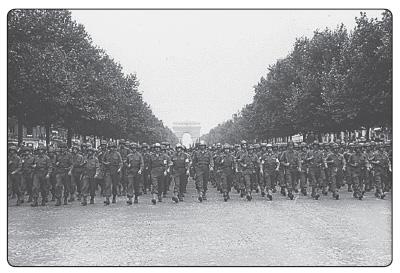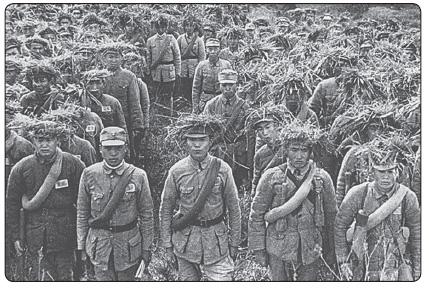The History Buff's Guide to World War II (14 page)
Read The History Buff's Guide to World War II Online
Authors: Thomas R. Flagel

Of sixteen million in uniform, only five million served overseas, illustrating how the United States was empowered by logistics and supply. Each American soldier in the field was supported by four tons of equipment. In comparison, material support for each Japanese soldier averaged out to a few pounds. Distance also mandated a high proportion of U.S. troops committed to supply. The United States stood three thousand to seven thousand miles away from most battle zones.
3

Reflective of their mountainous support network, only one in three U.S. servicemen served overseas.
Of Americans enlisted in the war, less than half possessed a high school degree.
4
. CHINA (14,000,000)
ENTERED WAR: 1937
PEAK STRENGTH: 5,700,000
Although China was the most populous nation on earth with nearly five hundred million inhabitants, it had the smallest percentage of combatants among the major powers. Less than 4 percent of all Chinese served in an army during the war. Never a single “armed forces,” China’s defense was more of a patchwork of regional militia, C
HIANG
K
AI
-S
HEK
holding the largest collection. His Nationalist forces initially held most of the country, but by 1938, Chiang and company were desperately holding on to the rural center around the city of Chungking (Chonqing).
In northeast China, the Communists were generally effective in winning over the population and debilitating the Japanese. As the empire concentrated troops in cities and along rail lines, the Communists operated around the pockets in between, blending into the local population and employing guerrilla tactics along vulnerable points. Only once did the Communists mount a large, organized offensive, the so-called Hundred Regiments Campaign in 1940. Killing more than twenty thousand Japanese, it also convinced Chiang that his rivals were becoming too powerful. From that point onward, the war was not China versus Japan but the Nationalists versus the Communists versus Japan.
4

Poorly armed and generally poorly led, the Chinese fought and died in large numbers.
Due to a lack of communication equipment, Chinese officers often had to be at the head of their columns in combat. As a result, the officer class died at a rate five times faster than the enlisted.
5
. JAPAN (9,100,000)
ENTERED WAR: 1937
PEAK STRENGTH: 7,500,000
Though it often appeared as if the Japanese navy was the largest branch of the imperial armed forces, the army outnumbered its naval counterpart, on average, three to one. The heaviest commitment had always been China, where Japanese manpower ranged from 800,000 to 1,500,000. The Allies rationalized backing the inept C
HIANG
K
AI
-S
HEK
on the belief that his Nationalists were “tying down” the bulk of the Imperial Army.
It was the army that achieved most of Japan’s great successes, conquering Hong Kong, Burma, the Dutch East Indies, Singapore, Malaya (Malaysia), and the Philippines. Of course, these would have been difficult if not impossible without the temporary dominance of the Imperial Navy.
Japanese armadas had a temporary advantage over their opponents. Although the Imperial Navy was the third largest in the world in 1941, it could concentrate its forces, whereas Britain and the United States had to disperse their warships across the globe. This competitive edge allowed Japan to score a string of phenomenal victories in late 1941 and early 1942, highlighted by the attacks on P
EARL
H
ARBOR
and the sinking of Britain’s treasured battleship HMS
Prince of Wales
off of Singapore, both achieved days within each other. Yet success was fleeting, so to speak.
The Imperial Navy had the two largest battleships ever made, the Yamato and Musashi. Each was nearly as long as three football fields and had 30 percent more displacement than the largest U.S. battleships ever built.
6
. ITALY (9,000,000)
ENTERED WAR: 1940
PEAK STRENGTH: 3,100,000
Although huge in number, the Italian armed forces were poorly outfitted and unmotivated. Far from cowardly in combat, the Italians were simply not prepared for the job. Tanks were of archaic design with flimsy armor and limited firepower. Artillery was at a tenth of the volume of World War I and outdated. The navy had no radar, no sonar, and no aircraft. The air force, what little there was, consisted of a fair number of biplanes.
Essentially, the military was a metaphor of the country—fragile and fragmented. Mussolini came to power by way of the militia, a.k.a. “the black shirts,” not by the support of the military. In twenty years, Fascist Party influence never took root among the armed forces. In fact, Italian soldiers and sailors were bound by oath to the king, not to Mussolini.
Facing defeat after defeat, the armed forces suffered long after the fall of il Duce. In 1943, the Wehrmacht invaded the country from the north, capturing and disarming more than three hundred thousand Italian soldiers, sending most of them to Germany as slave labor.
5
One of Italy’s defeats actually created an Axis victory. In November 1940, the RAF launched a surprise torpedo attack on Italy’s naval base in Taranto, sinking three battleships. Impressed by the results, the Japanese naval high command reasoned the same could be done against a fleet at Pearl Harbor.
7
. GREAT BRITAIN (5,896,000)
ENTERED WAR: 1939
PEAK STRENGTH: 4,683,000
The British Isles were predominantly a sea power at the outbreak of hostilities, with a navy ranked second in the world, but its navy was the smallest of the three military branches. From an overall population of 47 million, nearly 4 million served in the army, 1.2 million were in the RAF, and 900,000 were in the Royal Navy.
Arguably, Britain’s army bore the brunt of the war. In 1939 it numbered 400,000, smaller than the army of Belgium. Climbing to 1.6 million by 1940, Britain’s ground forces still went on to amass an extremely poor record, although not for lack of trying. Driven from France and Norway in 1940, then Greece and Crete in 1941, the British nearly imploded when they lost Singapore in early 1942. A following string of losses in Burma and North Africa did not help matters.
With the British armed forces stretched too thin across the empire, lacking reliable tanks and antitank guns, not until Second El Alamein did the royal luck turn for the better, mostly because of vastly superior numbers in vehicles and men. Combined operations with the United States from 1943 onward led to better fortunes in Sicily, Italy, and France.
Like the Soviet Union, Great Britain drafted women into service. By the end of the war, 10 percent of the British armed forces was female.
8
. FRANCE (3,500,000)
ENTERED WAR: 1939
PEAK STRENGTH: 2,680,000
France was a paradox. At its strongest, it lost. At its weakest, it prospered. In 1940, at its apex in men and equipment, with the fourth largest army and navy in the world, France suffered its worst defeat in the war, beaten in six short weeks on its home turf. Nearly half of France’s armed forces went through the war in captivity. The Third Reich captured 1.5 million Frenchmen and French colonials. Those who did not die or escape remained POWs or were slave laborers in Germany for the duration.
At the end of the war, ranking eleventh globally in military strength, playing a tertiary role in the liberation of its own country, France possessed zones of occupation in Germany and Austria.
6
A substantial cause of both scenarios was France’s global positioning. It started the war with three armies—one guarding France proper, one covering North Africa, and one guarding colonies elsewhere—a system heavily dependent on the work and sacrifices of colonial subjects.
In 1940, the setup compromised France’s military might on the Continent. In the interim, it was France’s savior. The Free French movement started its comeback when French Equatorial Africa decided to back Charles de Gaulle over Vichy France. Other colonies began to switch over, and the momentum changed for good with the Allied invasion of French Morocco and Algeria. By 1945, thanks to shrewd bargaining, the French were again a global power, albeit a military prune.
In 1940, the French army was ten times larger than the British army. In 1945, the British Army was ten times larger than the French.
9
. INDIA (2,581,800)
ENTERED WAR: 1939
PEAK STRENGTH: 2,200,000
When Britain declared war on Germany, the British viceroy for the colony of India stepped in and proclaimed India at war as well. This did not go over well with the three hundred million Indians who were not consulted. British demands for obedience in the hour of imperial need led to a general breakdown of order. Most of India’s prominent civil leaders were arrested, including pacifist Mohandas Gandhi.
When the war started poorly for Britain, London officials moved to secure greater cooperation from the subcontinent, eventually promising to grant India its independence once victory against the Axis had been achieved.
This promise of autonomy spawned an explosion. The Indian armed forces grew from 160,000 in 1939 to more than two million by 1944. All of them were volunteers. Predominantly led by white officers, the poorly equipped but highly motivated army sent divisions to Europe, North Africa, East Africa, the Middle East, and Southeast Asia. Most were stationed as home guard, protecting the geographically vital subcontinent from invasion and providing air bases for Allied air transport to China over “the Hump” of the Himalayas. India’s crowning achievement occurred in 1944 and 1945 when it successfully fended off a Japanese invasion from Burma and then secured the country for the Allies. Of the “British” forces in Burma, seven out of ten were Indian.
7
One of the problems with organizing the Indian armed forces was communication. At the time of the war, India (which included Pakistan and Bangladesh) was home to more than eight hundred languages and dialects.
10
. POLAND (2,400,000)
ENTERED WAR: 1939
PEAK STRENGTH: 1,200,000
As with France, Poland had one of the largest armies on earth when Germany invaded. Unlike France, Poland had no colonies to fall back on and no victory parades waiting in its future. Yet many Poles went on to achieve great successes in support of the Allied effort.
Of more than one million troops routed in the blitzkrieg of 1939, some ninety thousand managed to escape by way of Slovakia and Romania. Many trained in France and were part of the ill-fated defeat in 1940, while portions of the small navy, including two submarines, were able to make it to Britain and assist in convoys and coastal defense. The first bright moment came in the B
ATTLE OF
B
RITAIN
, in which the courage and marksmanship of Polish pilots accounted for one out of every eight German planes brought down.
While an untold number of regular army personnel formed the core of the resistance movement in and around Warsaw, exiled Poles served in North Africa, the eastern front, and Western Europe. Part of the N
ORMANDY
invasion and the less successful O
PERATION
M
ARKET
-G
ARDEN
, Poles had their finest hour in Italy, capturing the abbey heights in the fight for Cassino, losing thousands of men in the process, but succeeding where three other assaults by other nationalities had failed.
While stationed in Palestine, several thousand Polish soldiers of Jewish descent deserted their units to live in the area. One of them became a rather proficient militant activist by the name of Menachem Begin.